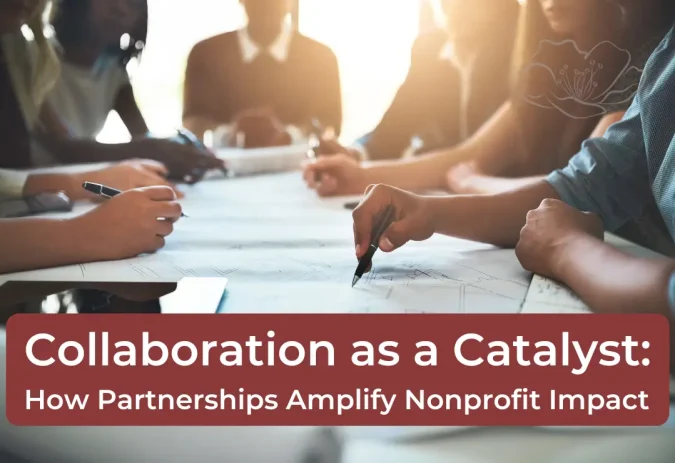
Collaboration as a Catalyst: How Partnerships Amplify Nonprofit Impact
In today’s complex social landscape, no single organization can solve major challenges alone. For nonprofits with limited resources and ambitious missions, strategic collaborations have become more than just a nice-to-have—they’re a necessity for sustainable impact. At Cherry Grove Creative, we’ve seen firsthand how partnerships between nonprofits and other organizations can transform communities and amplify social change.
Why Collaboration Matters for Nonprofits
Resource Maximization: Nonprofits operate in an environment of constant resource constraints. By joining forces with complementary organizations, you can pool funding, share administrative costs, and leverage each other’s infrastructure. This allows everyone involved to stretch their dollars further and reduce duplicate efforts in the community.
Expanded Reach and Visibility: When nonprofits collaborate, they gain access to each other’s audiences, donors, and stakeholders. A partnership between a small arts organization and a larger education nonprofit, for example, introduces both to entirely new segments of the community who might support their work.
Innovation Through Diverse Perspectives: Different organizations bring unique approaches and experiences to the table. When nonprofits collaborate across sectors or focus areas, they often develop innovative solutions that wouldn’t have emerged from working in isolation. These fresh perspectives can help break through longstanding challenges.
Enhanced Credibility and Trust: Strategic partnerships signal to donors and the community that your organization is forward-thinking and resource-conscious. Collaborative initiatives often receive more attention and trust from funders who see the combined expertise and commitment to efficient service delivery.
 Types of Powerful Nonprofit Collaborations
Types of Powerful Nonprofit Collaborations
Nonprofit-to-Nonprofit Partnerships: Collaborations between nonprofits serving similar missions or complementary causes can create powerful synergies. Consider how a hunger relief organization might partner with a job training nonprofit to address both immediate needs and long-term poverty reduction.
Cross-Sector Collaborations: Partnerships between nonprofits and for-profit businesses can drive sustainable impact. Companies bring resources, marketing expertise, and operational efficiency, while nonprofits contribute community knowledge and mission focus. These collaborations often result in innovative funding models and increased sustainability.
Academic Partnerships: Universities and research institutions make excellent partners for nonprofits seeking to evaluate their impact or develop evidence-based approaches. These partnerships bring academic rigor to nonprofit work while giving researchers real-world applications for their expertise.
Government Collaborations: Working with local, state, or federal government agencies can help nonprofits influence policy, secure sustainable funding, and scale successful programs. Though sometimes complex to navigate, these partnerships can lead to systemic change beyond what any single organization could achieve.
Making Collaborations Work: Best Practices
1. Start with Clear, Shared Goals
Successful partnerships begin with explicit agreement about what you hope to achieve together. Document these goals and ensure all parties are genuinely aligned on priorities and expected outcomes.
2. Define Roles and Responsibilities
Confusion about who does what can quickly derail even the most promising collaboration. Create clear documentation outlining each organization’s contributions, decision-making authority, and accountability measures.
3. Build Relationships, Not Just Projects
The strongest collaborations are built on trust and mutual respect between organizational leaders. Invest time in relationship-building beyond the specific project or initiative you’re working on together.
4. Communicate Transparently
Regular, honest communication prevents misunderstandings and keeps collaborations on track. Establish communication protocols early and create space for addressing challenges before they become problems.
5. Measure and Celebrate Joint Success
Develop metrics that track the collaboration’s impact and regularly assess progress. Share success stories broadly and celebrate achievements together to reinforce the value of the partnership.
Moving Forward: Is Your Nonprofit Collaboration-Ready?
To assess your organization’s readiness for strategic partnerships, consider these questions:
- What unique strengths do you bring to potential collaborations?
- Which organizational gaps might partners help you address?
- What mission-aligned organizations serve complementary purposes in your community?
- How might you structure a partnership that equally benefits all organizations involved?
 Nonprofits that approach collaboration strategically—with clear goals and thoughtful partnership selection—stand to gain tremendous benefits for their organizations and the communities they serve.
Nonprofits that approach collaboration strategically—with clear goals and thoughtful partnership selection—stand to gain tremendous benefits for their organizations and the communities they serve.
Remember that meaningful partnerships require investment. The time spent finding the right collaborators and building strong foundations will pay dividends in expanded impact and organizational sustainability.
At Cherry Grove Creative, we believe in the transformative power of strategic nonprofit partnerships. We’ve seen how the right collaborations can elevate messaging, extend reach, and ultimately help organizations fulfill their missions more effectively.
If you’re ready to explore how collaboration might strengthen your nonprofit’s work, we’re here to help you communicate your collaborative vision. Contact us to learn how!

